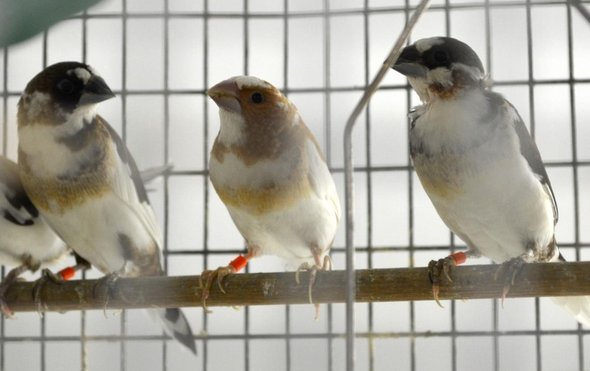(单词翻译:单击)
听力文本
This is Scientific American — 60-Second Science. I'm Christopher Intagliata.
In the most recent podcast we discussed how baby bats learn their calls from all the other bats in their crowded colonies. And we mentioned in passing that songbirds usually get tutored directory from their dads. So, how does that avian system work?
"At about 25 days, the father starts singing in many cases directly to the juvenile." David Mets, a geneticist at the University of California San Francisco. "That is the onset of what's called the sensory phase of learning. Where they incorporate information from their environment."
What Mets and his team wanted to know was how much of a baby bird's future musicality is influenced by that tutoring...an environmental factor...and how much is written in their genes. So they studied Bengalese finches... which sing like this. (finch clip 1)
The tempo of that song appears to vary, according to a finch's genetics. So they tried training baby finches, with different genetic tendencies — fast, medium or slow singing — on a synthetic finch song, made from a library of different types of song syllables. "So this is sort of maybe tonal downward sweeps, (whistle) you know. . Or sort of broadband noisy ones, like sshhhh."

But when baby finches with different genetic backgrounds were trained on the resulting tune (training song), the training didn't stick. Instead, the greatest predictor of their singing tempo was the way their fathers sang—which they'd never heard. So their genes seemed to be in charge.
But then Mets flipped the experiment—exposing genetically similar birds to actual live birds that sang fast, medium, or slow. And that live training appears to have been compelling enough to override the influence of the birds' genetics. So that genetically identical chicks sang tunes fast (fast clip) medium (medium clip) or slow (slow clip)...depending what their tutor sang. The results are in the Proceedings of the National Academy of Sciences.
The study suggests that the right kind of schooling...or environmental influences... might be able to overcome 'baked in' genetic influence on certain traits. And Mets says this push-pull of nature versus nurture might hold true for humans, too.
"We're moving very rapidly into a period where genetic data is easier and easier to collect. And an understanding of these kinds of gene-environment push/pull interactions, and how they impact ultimate phenotypic outcomes, is going to be important in understanding things like cancer susceptibility." Because that too has both genetic and environmental factors.
But no word yet on whether the genetic influences of an off-tempo human father...can be conquered with enough training.
Thanks for listening for Scientific American — 60-Second Science. I'm Christopher Intagliata.
参考译文
这里是科学美国人——60秒科学。我是克里斯托弗·因塔利亚塔。
在上期播客节目中,我们讨论了小蝙蝠如何跟拥挤的蝙蝠群学习叫声。我们还顺带提到了鸣禽通常直接从父亲那里得到指导。那鸟类的这种系统是如何运作的呢?
“多情情况下,在小鸟出生大约25天的时候,鸟爸爸会开始直接对着幼鸟唱歌。”加州大学旧金山分校的遗传学家大卫·梅茨说道。“这就是所谓的学习感知阶段的开始。幼鸟开始从环境中吸收信息。”
梅茨和团队都想知道,属于环境因素的这种指导会对幼鸟未来的音乐感产生多大影响,而写入它们基因中的音乐感又有多少。所以他们研究了孟加拉雀,它们的叫声是这样的。(雀鸟的叫声1)
这种叫声的节奏似乎会因雀类基因的差异而出现不同。所以他们试着训练具有快、中、慢等不同歌唱速度遗传倾向的小孟加拉雀,用不同类型的歌曲音节合成孟加拉雀的歌声。“这种合成歌声像音调下降的哨音,或嘘声这样的宽频嗓声。”
但是,当不同遗传背景的幼雀接受这种合成歌曲的训练时,训练会进行不下去。相反,歌唱节奏的最准确预测指标是它们父亲的歌唱方式,而这是幼雀从来没听过的。所以,看起来起决定作用的是它们的基因。
随后梅茨进行了对比实验,将基因相似的鸟放到真正生活在大自然的鸟群中,这些鸟的唱歌速度有快速、中等和慢速之差。这种实地训练似乎在克服基因影响上体现出足够的说服力。因此,基因相同幼鸟的唱歌速度是快速(快速唱歌音频)、中速(中速唱歌音频)还是慢速(慢速唱歌音频)取决于它们导师的唱歌速度。这项研究结果发表在《美国国家科学院学报》上。
该研究表明,正确的教学或环境影响,也许能够克服某些特征的基因影响。梅茨还表示,这种先天与后天的推拉式结构可能也适用于人类。
“我们正迅速进入一个基因数据越来越易收集的时代。理解这种基因环境的推拉式相互作用,以及它们如何影响最终的表型结果,对理解癌症易感性等方面具有重要意义。”因为癌症同样存在基因和环境这两种因素。
但是目前还不清楚通过足够训练,是否能克服音痴人类父亲的基因影响。
谢谢大家收听科学美国人——60秒科学。我是克里斯托弗·因塔利亚塔。
译文为可可英语翻译,未经授权请勿转载!
重点讲解
重点讲解:
1. in passing 顺便;顺带;
例句:I mention this point now in passing and shall refer to it again.
这一点现在顺便提一下,以后还会讲到。
2. sort of 有几分;近似;有那么点儿;
例句:n the end, she sort of pushed it.
最后,她几乎是用了推的。
3. in charge 主管;全面负责;统领;
例句:Until the doctor arrived from elsewhere on the ward, Amy was in charge.
在医生从别处赶到病房前,这里由埃米负责。
4. hold true 同样适用;在…情况下亦然;
例句:This law is known to hold true for galaxies at a distance of at least several billion light years.
据知,这条定律同样适用于距离至少几十亿光年之远的星系。


